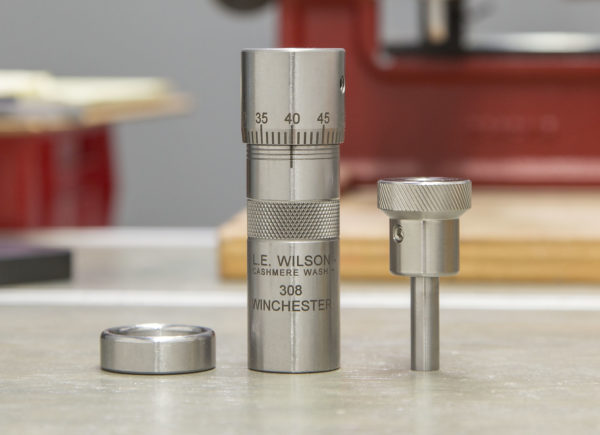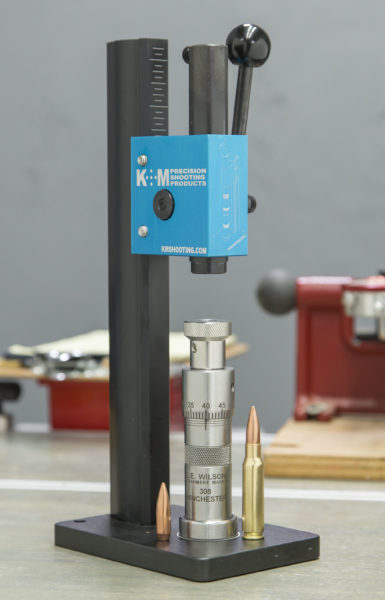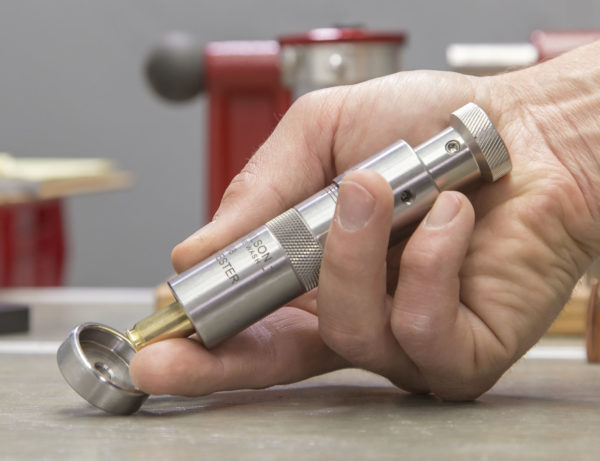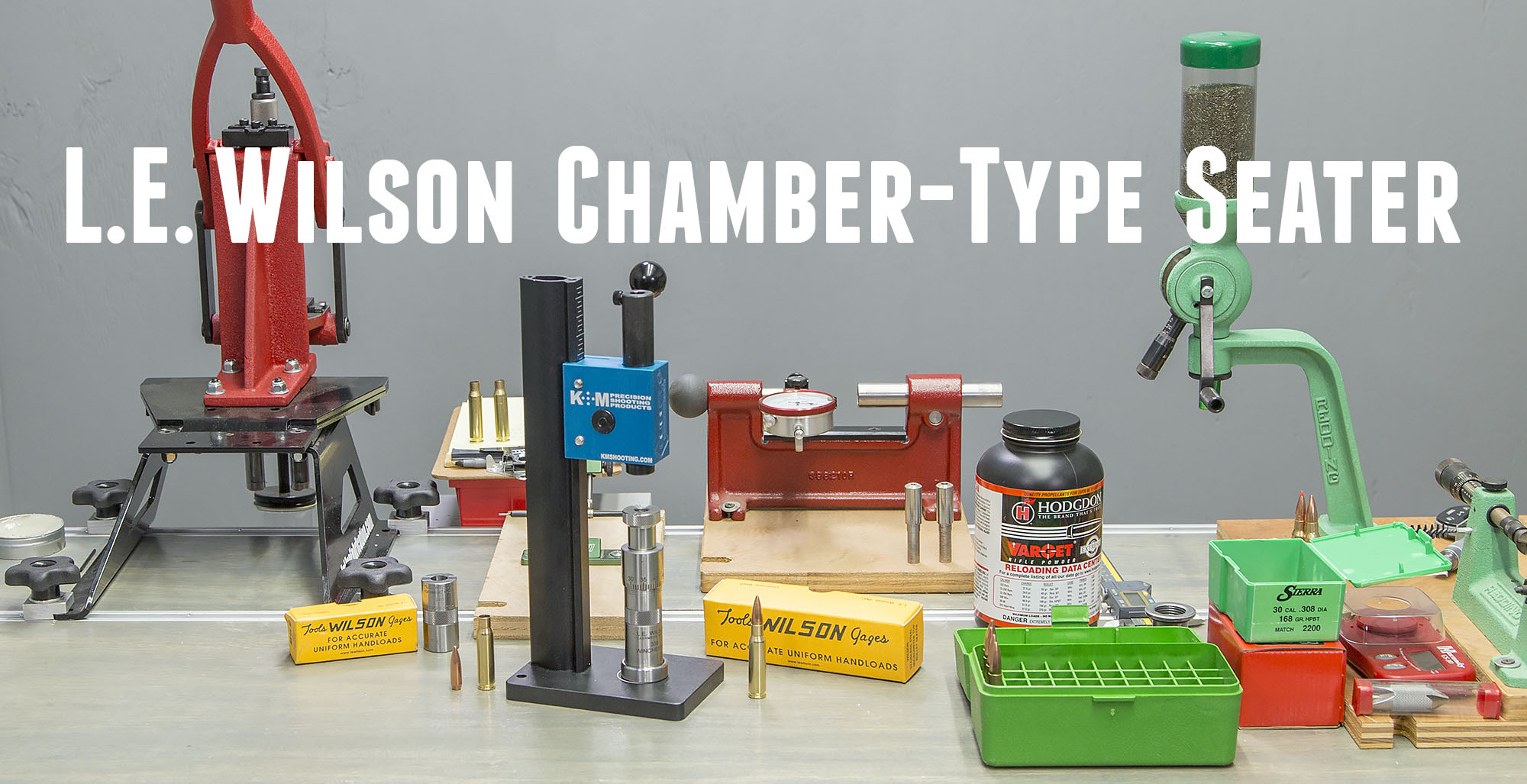A wobbling football doesn’t fly very straight. In the same way, a wobbling bullet will not group well at range. There are two major factors in eliminating bullet “wobble”: stabilizing the bullet properly (a function of bullet weight and rifling twist rate), and bullet/case concentricity. In this article, we’ll focus on concentricity, specifically bullet concentricity using the L.E. Wilson Chamber-Type bullet seater. If you haven’t used this type of seater before, prepare to see something “totally different”. So that you can see how this tool fits into the bigger picture, I’ve put together a start-to-finish look at loading precision ammunition with this bullet seater:
Precision Loading Distilled
I’ve covered many different aspects of precision reloading on this blog, but wanted to take a high-level look at the entire process here which includes:
- Fire-forming your brass to the chamber of the rifle you’ll be loading for
- Cleaning the brass
- Sizing and de-priming the brass
- Checking brass with a case gage and case neck thickness uniformity tool (and sorting if needed)
- Trimming, chamfering case mount, and other brass prep
- Priming the brass
- Charging the case
- Seating the bullet
- Checking bullet concentricity
There are MANY other steps that you can perform including annealing cases, uniforming flash holes, cleaning primer pockets, and many more processes. Many of these processes are only necessary (or worthwhile) for benchrest shooting. For most long-range rifle applications the shooter and wind will have much more affect on point of impact than cleaning primer pockets for example.
The Concentricity Equation
If you don’t want to have bullets that wobble like a slow-flying football, you need to nail the concentricity equation. The first step is to use a stability calculator like this one from Berger to ensure your velocity, rifling twist rate, and bullet weight are all in the proper “sweet spot”. Second, you’ll need to ensure you have uniform case neck thickness. You can size-then-measure-and-sort your brass, and you can even go the “extra mile” by turning your case necks. Starting with premium brass can make this case neck thickness uniformity consideration a non-issue. Third, you’ll need to ensure you have a good sizer die and have it setup properly. Bullets can’t engage the rifling concentric if the case neck is off-center from a bad full-length or neck-only sizer die. Finally, you need to have bullets seated concentric to the center axis of the case. That’s where the L.E. Wilson chamber-type seater die shines!

Above are the parts that make up the L.E. Wilson Chamber-Type Micrometer-Top bullet seating die. From left we have the base, the die body, and the seater cap with seating stem. This seating die can be used without a press, even with a soft-faced hammer. But the best way to seat bullets using this die is with a small arbor press. L.E. Wilson recommends the K&M Precision arbor press which was designed with this seating die in mind.

What’s unique about how this die works is the moving parts/components involved. With a conventional bullet seating die, the case and bullet move upwards into the case while the bullet is seated. Some dies employ sliding collars which hold the case and bullet in alignment while the bullet is seated, but there are always “tolerances” invoked which can lead to more “slop” in concentricity. The L.E. Wilson Chamber-Type bullet seating die holds the case stationary while the bullet is pressed down into the neck of the case. This translates to less moving parts, tighter tolerances, and ultimately more concentric bullet seating results.

Above you can see the case being removed from the L.E. Wilson Chamber-Type bullet seater. It’s actually quite fast and easy to use. Here’s the process:
- Take a charged and primed case, place a bullet onto the case mouth
- Insert the case and bullet into the seating die body
- Place the seating die on the base (on the arbor press)
- Use the arbor press to press down on the seating cap until it bottoms out
- Lift the die body off the base
- Remove the completed cartridge from the die body (may help to pull up on seating cap, and you can gently pry on case rim with a flat blade screw driver if case fits tightly in die)
To adjust bullet seating length, you just loosen the Allen screw, then twist the micrometer collar. You can easily make adjustments based on the 1/1000″ marks on the graduated scale. Now that’s nice!
This sounds like a lot of steps, but in actual operation it’s only about 10-15 seconds per cartridge when you get into the flow. What’s nice about this kind of arbor press setup is that you can “feel” what’s going on with bullet seating the entire distance the bullet is seated. Additionally, there’s a “force pack” available for the K&M arbor press which reads the seating force in pounds over the distance you seat the bullet. That would be very nice to have!
Summary
If you need to load precision ammunition, the concentricity equation is an important one to solve! Ensuring optimal case neck concentricity, case neck thickness uniformity, and bullet concentricity are critical steps towards achieving your goals for long-range precision shooting. If you need the utmost precision in your bullet seating concentricity you should check out the L.E. Wilson Chamber-Type bullet seater. It’s a lifetime precision tool that takes the guess work and frustration out of match-grade bullet seating.



















































































Im looking for some kind of concentric press/machine. I surely wish the sport shop would have a ‘hands-on-day’ where several different devices could be tried.
There are several good devices available but I cant afford 2 or 3 till I get the one I really wanted first. Kinda like holsters. Everone has a box full that didnt make the cut. How many bucks in that box??
These products are investments and are in another league when it comes to accurate shooting. Everyone knows that L. E. Wilson is top shelf and I love to add to my collection of their tools. Thanks for the great article.
I just purchased the L.E. Wilson Chamber type bullet seater in 223. Using the K&M arbor press my bullet runout has disappeared. Concentricity gauge shows a variance of less than 0.0001 on each round. I am so impressed I am going to get one for each of my precision calibers. 6.5 CM, 6 CM, and my 308 F/TR.